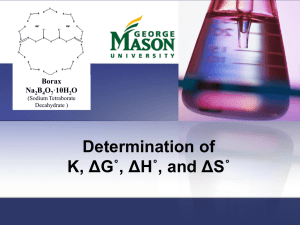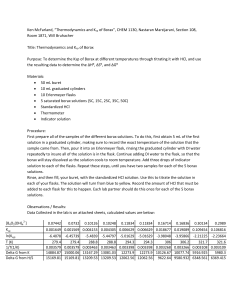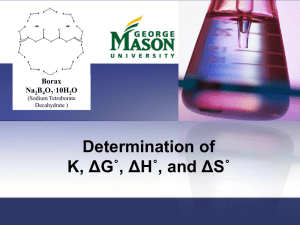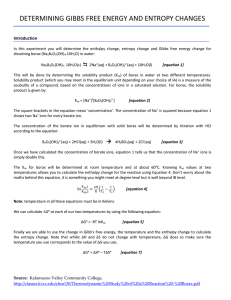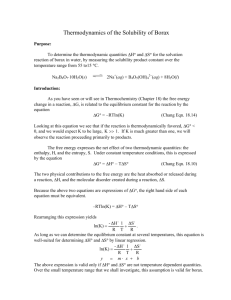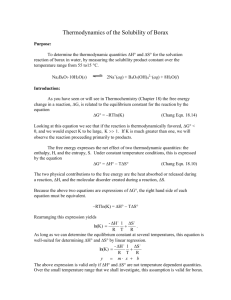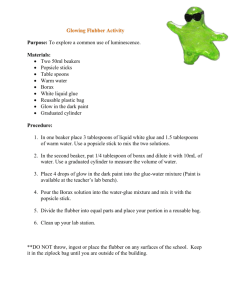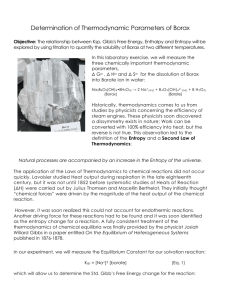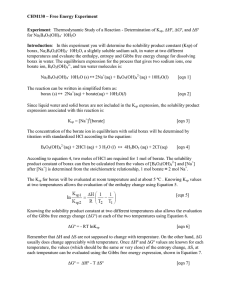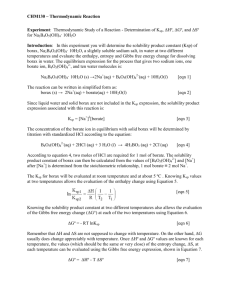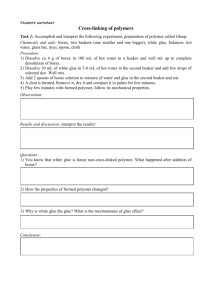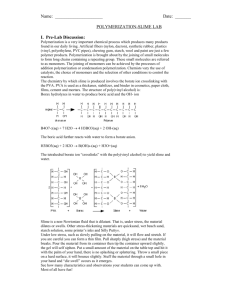ENTHALPY AND ENTROPY OF A BORAX SOLUTION
advertisement
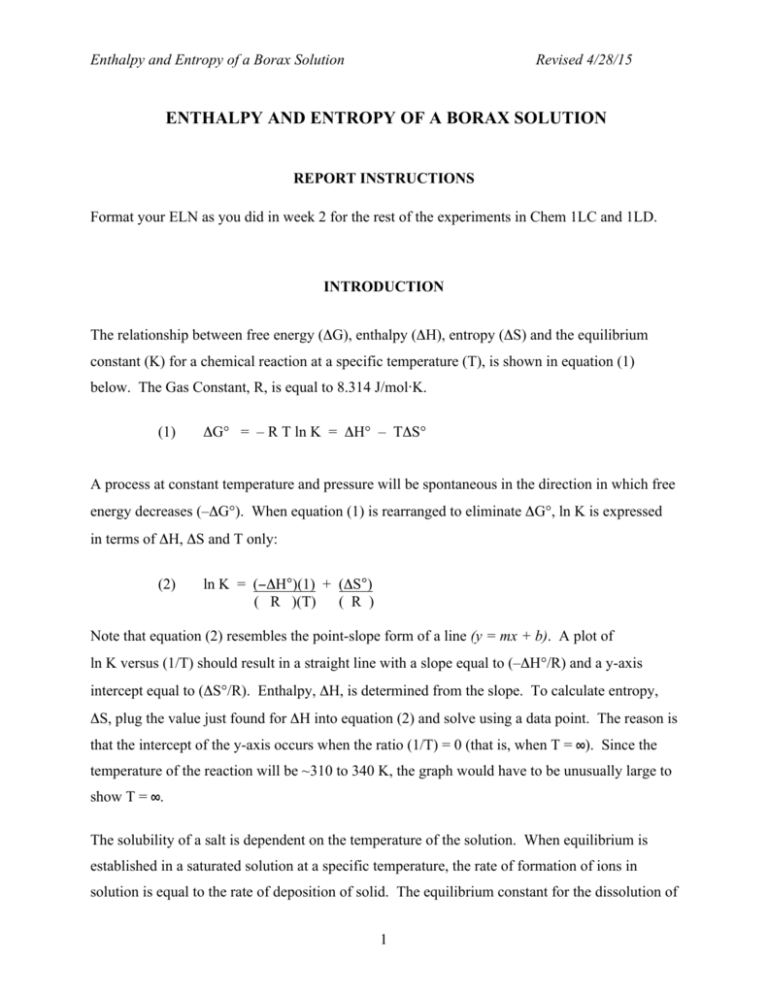
Enthalpy and Entropy of a Borax Solution Revised 4/28/15 ENTHALPY AND ENTROPY OF A BORAX SOLUTION REPORT INSTRUCTIONS Format your ELN as you did in week 2 for the rest of the experiments in Chem 1LC and 1LD. INTRODUCTION The relationship between free energy (ΔG), enthalpy (ΔH), entropy (ΔS) and the equilibrium constant (K) for a chemical reaction at a specific temperature (T), is shown in equation (1) below. The Gas Constant, R, is equal to 8.314 J/mol·K. (1) ΔG° = – R T ln K = ΔH° – TΔS° A process at constant temperature and pressure will be spontaneous in the direction in which free energy decreases (–ΔG°). When equation (1) is rearranged to eliminate ΔG°, ln K is expressed in terms of ΔH, ΔS and T only: (2) ln K = (−ΔH°)(1) + (ΔS°) ( R )(T) ( R ) Note that equation (2) resembles the point-slope form of a line (y = mx + b). A plot of ln K versus (1/T) should result in a straight line with a slope equal to (–ΔH°/R) and a y-axis intercept equal to (ΔS°/R). Enthalpy, ΔH, is determined from the slope. To calculate entropy, ΔS, plug the value just found for ΔH into equation (2) and solve using a data point. The reason is that the intercept of the y-axis occurs when the ratio (1/T) = 0 (that is, when T = ∞). Since the temperature of the reaction will be ~310 to 340 K, the graph would have to be unusually large to show T = ∞. The solubility of a salt is dependent on the temperature of the solution. When equilibrium is established in a saturated solution at a specific temperature, the rate of formation of ions in solution is equal to the rate of deposition of solid. The equilibrium constant for the dissolution of 1 Enthalpy and Entropy of a Borax Solution Revised 4/28/15 a solid in a solvent is called the "solubility product constant" (Ksp). It is equal to the product of the concentration of ions in solution. Since the concentration of ions can change with temperature, Ksp is temperature dependent. Sodium tetraborate decahydrate ("borax") dissociates in water to form sodium and borate ions and water molecules: (3) Na2B4O7.10 H2O(s) ! 2Na+ (aq) + B4O5(OH)42-(aq) + 8H2O(l) And the solubility product (equilibrium) constant, Ksp, is: (4) Ksp = [Na+]2 [B4O5(OH)42-] Note that two sodium ions are produced for each borate ion (B4O5(OH)42-) in the reaction. Therefore, the concentration of Na+ is TWICE the concentration of borate ion: (5) [Na+] = 2 [B4O5(OH)42-] The equilibrium constant can now be expressed in terms of borate ion concentration alone by substituting the equality from (5) into equation (4), and can be calculated when the borate ion concentration at equilibrium is determined. (6) Ksp = 4 [B4O5(OH)42-]3 Since borate ion is a base, its concentration can easily be determined by a simple acid-base titration. The endpoint is signaled by the color change of bromocresol green indicator. (7) B4O5(OH)42- + 2H+ + 3H2O ! 4 B(OH)3 Example: A student prepared 5.00-mL of borax solution at 59.2°C. He diluted the solution in a flask and titrated it to an endpoint with 27.05 mL of 0.500 M HCl. His calculations are: 0.500 mol H+ x 0.02705 L x 1 mol B4O5(OH)42L 2 mol H+ = 1.35 M B4O5(OH)420.00500L 2 Enthalpy and Entropy of a Borax Solution Revised 4/28/15 ln Ksp = ln (4(1.35)3) = 2.29 When graphing ln Ksp he would use inverse Kelvin temperature, 3.01 x 10-3 K-1. In today's experiment, students will prepare 5 saturated borax solutions at temperatures between 40° and 65°C. Each solution will be titrated with dilute HCl to determine borate ion concentration and Ksp. The enthalpy (ΔH) will be determined from a plot of ln Ksp versus 1/T and the entropy (ΔS) will be calculated from equation (2). PROCEDURE CAUTION: Safety goggles and aprons must be worn at all times in the lab. Before starting the experiment, the TA will asks one of you to do a quick demonstration or talkthrough one of the following: 1) How to properly fill a buret 2) How to read the volume amount on a buret 3) How to neutralize an acidic solution with sodium bicarbonate (NaHCO3) 4) How to make a 250 mL of a dilute solution of 0.5 M HCl from 5 M HCl Part A. Borax Solution Sampling Work in pairs. For best results, allow the saturated solution to stand at each temperature for at least 10 minutes to establish equilibrium between ions and solids at that temperature. Do NOT transfer any solids when pouring the saturated solution into the graduated cylinder. If a "scum" forms on the top of the solution, use a disposable pipet to transfer the clear liquid from the middle of the solution to the graduated cylinder. Do NOT create more than one solution – each 5 mL portion should be removed from the same solution after cooling. In a 250-mL beaker, dissolve approx. 25-30 g of borax in 50-75-mL of DI water. Heat gently with stirring to 65°C. CAUTION: Hot glassware can cause burns; handle carefully. If all 3 Enthalpy and Entropy of a Borax Solution Revised 4/28/15 solid dissolves, add a LITTLE more borax to the solution until a TINY amount of excess solid is present and the solution is COMPLETELY SATURATED. Allow the solution to cool to approximately 60°C (by turning down the hot plate slightly) and keep the temperature constant for about 10 minutes to equilibrate ions and solids. Additional solids may precipitate out at the lower temperature but this is expected. At the end of 10 minutes, pour the solution into a small graduated cylinder until the level exactly reaches the 5.00-mL mark. Be very careful not to transfer any of the solid borax from the beaker to the cylinder. Record the exact temperature of the solution. Immediately transfer the contents of the graduated cylinder to a clean 125-mL Erlenmeyer flask. Rinse the cylinder with several portions of warm deionized water, adding the rinsings to the flask. If any crystallized solid remains in the cylinder, add water and heat gently in a water bath until the borax dissolves; transfer dissolved borax to the flask. Add sufficient deionized H2O to the flask to keep the borax completely dissolved. Add 2-3 d of bromocresol green indicator to the flask. The borate ion is a base. What color is your indicator in base? Clean the graduated cylinder and repeat the steps above cooling the solution to ~55°C, ~50°C, ~45°C and ~40°C. Be sure to record ACTUAL temperatures at the time the sample is withdrawn from the saturated solution in the 250 mL beaker. Collect the sample in a graduated cylinder and label the 125 mL Erlenmeyer flasks accordingly. When you are finished with this step, wash the beaker and graduated cylinder thoroughly. Solidified borax is difficult to remove if ignored too long. Part B. Titration of Samples CAUTION: Dilute solutions of acid can cause irritations and burns; wash contaminated areas thoroughly with cold water. Before coming to lab, develop a plan in your ELN to dilute a ~5 M stock HCl solution provided by the stockroom to create 250 mL of ~0.5 M HCl solution. This plan should include a dilution calculation using a 250 mL volumetric flask and a graduated cylinder to measure the amount of stock solution. Clearly indicate the procedure used to make the solution in your electronic lab notebook. Then calculate the accurate concentration (with the 4 Enthalpy and Entropy of a Borax Solution Revised 4/28/15 correct significant figures) for the solution based on the actual concentration of the stock HCl solution given in lab. For the solution in each 125 mL Erlenmeyer flask, fill a clean 50-mL buret with a 0.500 M HCl solution. Drain a few mL of the acid into a large beaker (>800 mL) to remove air bubbles trapped in the stopcock. Add one drop of bromcresol green to the acid in the beaker and set aside. What color is your indicator in acid? Once you've determined what the indicator colors are in acid and base solution, titrate the borate ion solution to an endpoint with HCl. (If any solid has appeared, add small amounts of deionized H2O to redissolve before titration.) When you finish each titration, pour the solution in the Erlenmeyer flask into 1000 mL beaker and set aside. When you have completed all titrations, add the remaining HCl from your buret to the large beaker containing titrated solutions. Rinse the buret and buret tip and add the rinsings to the beaker. The solution will be acidic. Place about ½ inch of solid NaHCO3 in the bottom of another 1000 mL beaker, add water until it barely covers the NaHCO3, stir to make a slurry. Now slowly pour the diluted acidic solution from the first 1000 mL beaker into the bicarbonate slurry and stir. When foaming stops, check the solution with pH paper. If pH = 7, pour the neutralized solution down the drain. If the pH of the solution is less than 7, prepare a new slurry and neutralize the solution again in the same manner. (1) H+(aq) + NaHCO3(s) ! Na+(aq) + CO2(g) + H2O(l) Clean workspace and glassware thoroughly. Before leaving lab, copy another pair’s data table for this experiment. CALCULATION, DISCUSSION, & ERROR ANALYSIS Calculations should be performed on the data you collected and the data that the other pair collected. (Therefore, each trial and the standard have two sets of data.) It should be clear to the TA which data is yours. 5 Enthalpy and Entropy of a Borax Solution Revised 4/28/15 1. Calculate the concentration of borate ion for each titration. Use the borate ion concentration to determine Ksp at each temperature. Convert Celsius temperatures to inverse Kelvin temperatures (1/T) and summarize your data and calculated values in a table with 5 columns: T(K), 1/T(K-1), [borate ion], Ksp, and ln Ksp. 2. Plot ln Ksp vs 1/T(Kelvin). Clearly display the equation and the R2 value on the plot. If the R2 value falls below 0.90, remove the data point that appears to be the outlier and replot. (Both plots, with and without the outlier, should be turned in.) Determine ΔH (kJ/mol) and ΔS (J/mol-K) from the plot’s equation. 3. The literature values for enthalpy and entropy of the dissolution of borax in water are 110 kJ/mol and 380 J/mol-K, respectively. Determine the percent error in your experimentally determined values. 4. Answer the following questions by discussing pertinent observations and data: a. Does the solubility of borax in water increase or decrease as temperature increases? b. Is the solvation of borax in water an exothermic or endothermic process? c. Did ΔSsys increase or decrease in this reaction? 5. Is the dissolution of borax in water a temperature dependent reaction or is it spontaneous at all temperatures at which water is liquid? Briefly explain. QUALITATIVE ERROR ANALYSIS 1. What modifications could be made to the procedure to better account for random (indeterminate) errors? 2. List three potential systematic (instrumental, methodological, or personal) errors that could be made in this experiment. (Note: Be specific, systematic errors are in the details. For example, losing your solution because you knocked over the cuvette is not a systematic error – it’s a gross one.) 3. Did any gross errors occur? Did you mess up? Did the equipment or instrumentation fail? 6
